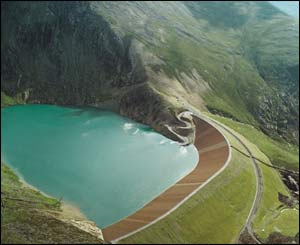I gave a brief outline of some of the challenges facing the UK electricity system in my last post on Neighbourhood electricity demand management. Here’s a bit more detail on what is happening in the UK electricity system, and why ‘demand response’ might be a good idea.
There are broadly 3 types of electricity generation:
Baseload supply: electricity generation which is constant and predictable, but not responsive to demand. This primarily consists of nuclear power, but can also include coal fired power stations, which are more expensive to ramp up and ramp down than gas fired power stations. Contrasted with dispatchable or intermittent supply.
Dispatchable supply: sources of electricity generation which can be turned on and off to match demand. This includes coal and gas fired power stations, and storage such as dinorwig hydroelectric barrage. Distributed generation such as electricity demand led CHP could also be added to this category. Contrasted with intermittent or baseload supply.
Intermittent supply: electricity generation which is sometimes available, but does not follow supply. This includes wind and solar power which are partially predictable through weather forecasts, and tidal power, which is fully predictable but not very modifiable, as well as some other renewables. Contrasted with dispatchable or baseload supply.
Responding to climate change by increasing the amount of renewables (and potentially nuclear power) inputting to the national grid increases the amount of intermittent and potentially baseload. The proportion of dispatchable supply, which is what allows supply to match demand, reduces, and this can lead to a risk of blackouts at times of peak demand, even if on average over the year supply matches demand.

Electricity is difficult to store, although we have some storage capacity in the UK via Dinorwig pumped storage facility in Wales, that can release a lot of power very quickly at short notice. There isn’t much potential to increase this capacity, however.
At the moment, we’re very used to getting electricity as soon as we want it, and electricity network operators are obliged by regulation to make sure supply matches demand at all times. There might be huge infrastructure investment savings (i.e. not having to build new power stations), if we can make our demand match supply more closely.
How would we change this though? Why should consumers change their electricity use habits if that benefits multinational electricity supply companies? Why would I change my habits if everyone else wasn’t doing it? What can be changed? I probably wouldn’t notice if my fridge stopped using electricity and heated up a little bit for a couple of hours at peak times, but would I be willing to delay having a cup of tea for a couple of hours? What about doing laundry? Sarah Higginson at Loughborough University has shown that people’s energy use practices are flexible – much more flexible than policy makers think – but that they are influenced by a complex variety of factors. Needing specific clothes to be very clean for work or school, not wanting to do laundry when sleeping, or choosing sunny days when the washing can be hung outside, are all factors that affect our laundry practices, and that we respond flexibly to.
Could we have a similarly flexible response with other energy uses? What about drinking tea? In places where people cook on electric rather than gas hobs, what if the local social club or community centre cooked a meal for the whole neighbourhood (with energy economies of scale from cooking for many people), and everyone went to eat together there, instead of cooking at home, on days where there was limited electricity available?
These are the kinds of questions being explored in our community smart grid project.

One thought on “Why and How? UK electricity demand response”